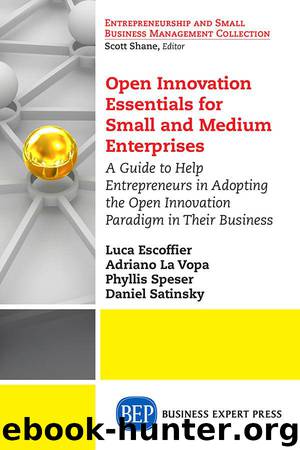Open Innovation Essentials for Small and Medium Enterprises: A Guide to Help Entrepreneurs in Adopting the Open Innovation Paradigm in Their Business by Escoffier Luca & La Vopa Adriano & Speser Phyllis & Stainsky Daniel

Author:Escoffier, Luca & La Vopa, Adriano & Speser, Phyllis & Stainsky, Daniel [Escoffier, Luca]
Language: eng
Format: azw3
Publisher: Business Expert Press
Published: 2016-02-08T05:00:00+00:00
Figure 4.6 Bottom-up approach
Use of Your Own Network
Consider an SME that operates in the furniture business. The firm has about 150 employees and a turnover of about $20 million. Our SME is proud to be a customer-centric company. Indeed, acting in the B2C environment, they have to be very attentive to the trends of fashion, to the different regional preferences where they sell their products, to the different offerings of competitors, and, of course, to the range of tastes of their customers. Although such a company has a strong department of designers, engineers, and technicians who are capable of coming up with extremely good ideas, in 2007, they saw a downturn of about 15 percent in their profits. After some analysis of the causes of the downturn, they realized it was not enough to blame the global recession as there were bright spots in Asian and other emerging markets that they had failed to exploit. Facing this challenge head-on, the company decided to invest in creating their own network of sales advocates and advisors. To build this network, they reached out to customers, designers, architects, journalists, and others who played important roles in furniture markets around the world. They posted their newsfeed’s existence to social media as well as the traditional trade press and blogs. For anyone who registered, they offered a free subscription to the company’s internal synopsis of each day’s news about the furniture business, design trends, and new or improved materials for furniture. By doing so, in a very short time, the company had gathered a substantial crowd, which was interested in innovative ideas for furniture. By adding incentives (primarily recognition and honors) for posting to their news and comment feed, they created a crowd that was very participative and extremely keen to compete on new product idea generation.
In this bottom-up approach, the company can add its own posts and news to “indicate the way” to their crowd. By adding permissioning to their blog or newsfeed, they can allow employees to make comments that are not seen by nonemployees. Thus, internal and external contributors belong to the same cloud, even though there are different subcommunities within that cloud
Bottom-up innovation has both pros and cons.
By opening up, the company enhances its goodwill and reputation as an innovation leader in the industry. It can encourage external people to submit their product ideas and suggestions. By being more open and transparent to customers, it advertises that it wants to hear their voice and demonstrates their voice is really heard and put into practice. It can tap into the collective wisdom and creativity of the crowd to develop ways to respond to posted suggestions for products and product improvements.
On the contrary, opening up carries risks because the company is more exposed to external parties. Competitors could also use the discussion on its portal to develop better products that respond to consumer preferences.
What this discussion highlights is that open innovation cannot be practiced without thinking about the other activities and capabilities of the company.
Download
This site does not store any files on its server. We only index and link to content provided by other sites. Please contact the content providers to delete copyright contents if any and email us, we'll remove relevant links or contents immediately.
Pioneering Portfolio Management by David F. Swensen(5599)
Zero to One by Peter Thiel(4816)
Man-made Catastrophes and Risk Information Concealment by Dmitry Chernov & Didier Sornette(4728)
The Motivation Myth by Jeff Haden(4521)
The Miracle Morning by Hal Elrod(3903)
Elon Musk by Ashlee Vance(3449)
The Art of Persistence: Stop Quitting, Ignore Shiny Objects and Climb Your Way to Success by Michal Stawicki(3365)
Unlabel: Selling You Without Selling Out by Marc Ecko(2975)
Urban Outlaw by Magnus Walker(2946)
Delivering Happiness by Tony Hsieh(2917)
Purple Cow by Seth Godin(2694)
Mastering Bitcoin: Programming the Open Blockchain by Andreas M. Antonopoulos(2504)
The Content Trap by Bharat Anand(2488)
The Marketing Plan Handbook: Develop Big-Picture Marketing Plans for Pennies on the Dollar by Robert W. Bly(2408)
The Power of Broke by Daymond John(2373)
The Airbnb Story by Leigh Gallagher(2363)
Applied Empathy by Michael Ventura(2323)
Radical Candor by Kim Scott(2210)
The Startup Way by Eric Ries(2154)
